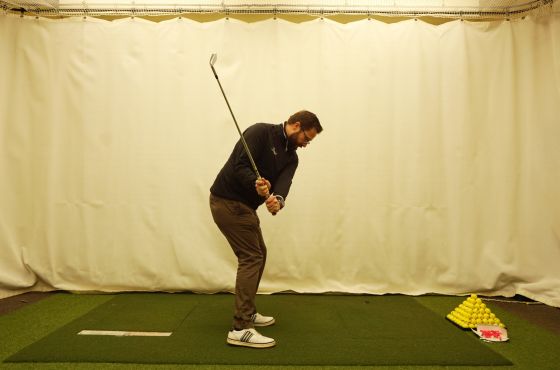This is what you should focus on during your Leadbetter seven-minute practice

You’ve pushed past the sticking point in your swing, broken free from tradition and discovered David Leadbetter’s A Swing.
If you’re familiar with Leeds Golf Centre you’ll know that we’re the Leadbetter Golf Academy UK Headquarters. So to help you on the path to success, Chris, our Leadbetter Academy Director, shares what you should be paying extra attention to as you’re running through your A Swing seven-minute practice plan.
Developing a good set up
Read through the first step of the practice plan and then really focus on the following key points:
- Stand nice and upright, and keep your club in line with your spine angle.
- For good balance and posture, bend from the hips, not the waist.
- Make sure your lower back stays straight, rather than rounded. Your triceps should be connected to your oblique muscles for your arms to hang naturally. The right arm should be a touch lower than the left.
- As you tilt your upper body slightly forward, strive to keep your chest up and shoulder blades down.
- Be sure to distribute your weight through the arches of your feet throughout. Keeping your weight central, and not too far forward or back, is key to a winning foundation
Grooving the pivot
Starting from your original set up position, and leaving your club on one side for now, follow the second step instructions. And while you run through the pivot motion, concentrate on really using your core to pivot your body and achieve that rhythmical movement.
Chris says, “Everything you do at address is designed to activate your mid-section. David’s whole theory is ‘to get the dog to wag the tail’. In other words, the body moves first and the arms follow what the body does. By simplifying the motion and moving your body correctly, you’ll be amazed how the club finds its own position without you trying to consciously put it there.”
Slotting the top of your backswing
Memorise the third step movements and pay particular attention to ensuring that your club’s shaft leans a touch to your right. It’s also important to:
- Maintain the spine angle that you achieved during set up so try not to let this slip.
- Be sure to keep your left arm in check too. There should be a connection between the arm and upper torso throughout the backswing and your arm should sit slightly below your shoulder line.
- Sustain the angles in the back of your wrists that you had when you first gripped the club.
Feeling the backswing, slotting the downswing
This step is all about working on keeping the hands in and the club out. It might feel unusual at first but splitting your hands on the club is a major element of this stage, it will really help you to concentrate on your hand and arm movements. Here are the key things to remember:
- Almost aligning the angles of your club and your spine, when you’re halfway back, is paramount to a perfect V plane.
- When your club reaches the halfway down point, it should be parallel to the original club angle (as from the address position).
Training the proper left-side release
The fifth step of the practice plan centres on keeping the connection between your arms and body throughout the motion. Don’t be afraid to turn your club upside down during this step if it’s feeling too heavy!
If you’re struggling with this movement, Chris recommends his trusty towel method. Take a towel, roll it up lengthways, and then tuck it under your arms and around your back. Lightly squeeze your arms against your body to hold the towel in place while you work through the motions. If you drop the towel, something’s not quite right and you need to refer back to the step by step instructions.
Developing feel
Chris’ final words of advice, when it comes to internalising each stage of the practice plan, are to keep the motion moving. This is the part where you need to close your eyes and join up the full swing to feel your arms, body and club working together to achieve fluidity.
Keep at it and this will all become second nature in no time! If you’d like to delve further into David Leadbetter’s approach to golf and take things to the next level, Chris is available for one-to-one tuition. Find out more, here